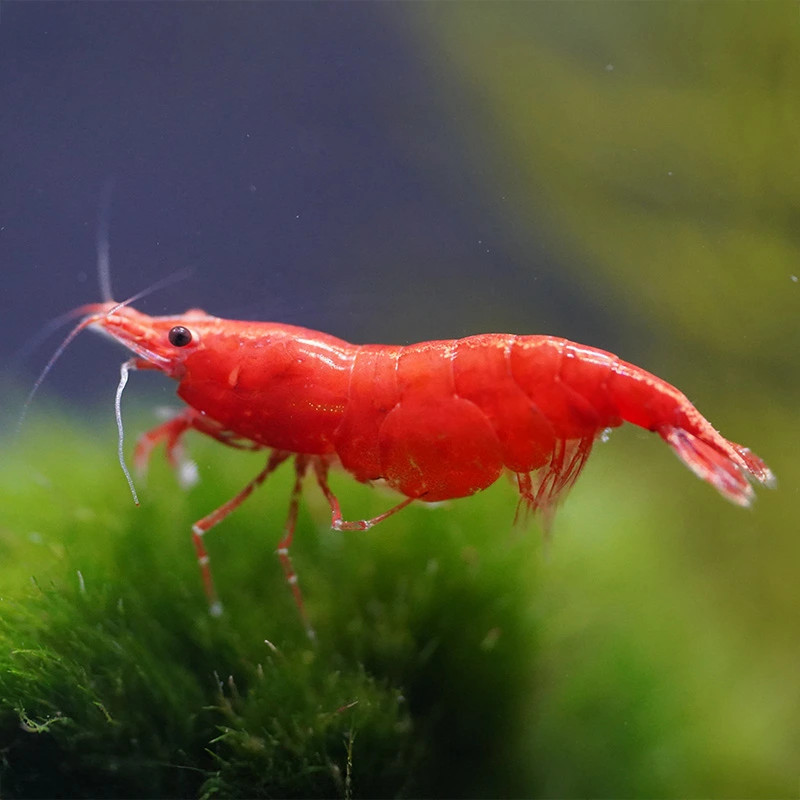Stocks Available
BLOODY MARY
SKU:118221
NEOCARIDINA DAVIDI
N/A

Stock Available
Introduction:
• Common Names: Red Cherry Shrimp
• Natural Habitat: Native to freshwater streams and rivers in Southeast Asia, commonly found in slow-moving, warm waters with plenty of plant cover and hiding spaces.
Physical Characteristics:
• Appearance: Small and slender with a striking red coloration that can range from a deep cherry red to a vibrant scarlet hue. Some individuals may have a translucent body with red speckles, giving them a glazed appearance.
• Size: Typically grows up to 1.5 inches (4 cm) in length.
• Lifespan: Can live for up to 1-2 years with proper care in a stable environment.
Habitat Requirements:
• Tank Size: A minimum of 10 gallons is recommended for a small group; larger tanks are ideal for a thriving colony.
• Water Conditions:
o Temperature: 70-78°F (21-26°C).
o pH: 6.5-7.5.
o Hardness: Soft to moderately hard water.
• Aquascaping: The aquarium should have plenty of live plants, driftwood, and smooth rocks to offer hiding spots and surfaces for biofilm to grow, which serves as food for the shrimp.
Diet:
• Primary Diet: Omnivorous, feeding on algae, biofilm, decaying plant matter, and leftover fish food.
• Supplemental Feeding: In addition to natural grazing, they should be provided with high-quality shrimp pellets, blanched vegetables (such as spinach or zucchini), and occasional protein-rich foods like daphnia or brine shrimp.
• Feeding Frequency: Feed once a day or as needed, ensuring that there is always a food source for the shrimp to graze on.
Compatibility:
• Temperament: Peaceful and non-aggressive, ideal for community tanks.
• Suitable Tank Mates: Best kept with other peaceful species such as small tetras, snails, or other shrimp species.
• Incompatibilities: Avoid aggressive or predatory fish that may view the shrimp as food, such as large cichlids or certain species of catfish.
Care Level:
• Difficulty: Easy to moderate; they require stable water parameters and are sensitive to sudden changes.
• Health Monitoring: Monitor for signs of molting issues, disease, or stress, such as a loss of color or excessive hiding. Maintain good water quality to prevent common shrimp diseases like bacterial infections.
Breeding:
• Breeding in Captivity: Red Glaze Shrimp breed readily in aquariums with stable conditions. They are known for their ability to reproduce quickly.
• Spawning: Females carry eggs under their tail, which hatch into larvae. These larvae eventually develop into juvenile shrimp that resemble adult shrimp.
Economic Considerations:
• Market Demand: Highly sought after by aquarists for their bright color and small size, making them popular in both nano and community aquariums.
• Pricing: Generally affordable, though high-quality or selectively bred individuals with intense red coloration may command a premium price.
Conclusion: Red Glaze Shrimp are an excellent addition to freshwater aquariums, valued for their vibrant color and algae-control abilities. Their peaceful nature and ease of care make them suitable for both beginner and experienced hobbyists. With proper tank maintenance and attention to water quality, they can thrive and contribute to the aesthetic beauty of any aquascaped tank.
Data sheet
16 other products in the same category:
Customers who bought this product also bought: